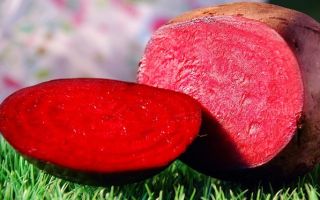Beetroot is a biennial herbaceous plant with a thick root (root crop).
Content
Description and composition
The part of the plant used for treatment is the leaves and roots and their juice.
Leaves are harvested in June-August, roots - in September-October.
Beets contain useful substances such as
- vitamins B1, B2, C, beta-carotene,
- folic, citric, malic acids,
- sugar,
- proteins,
- pigments,
- calcium,
- iron,
- magnesium,
- phosphorus,
- potassium,
- zinc,
- fiber.
Properties
Beets perfectly cleanse the body, especially the intestines, liver, kidneys, and gall bladder.
Scientific research has confirmed the high healing properties of red beets. It has been established that fiber and acids enhance intestinal motility, betaine promotes the breakdown and absorption of food proteins and is actively involved in the formation of choline, which increases the vital activity of liver cells. Therefore, it is recommended for chronic constipation, digestive disorders and liver diseases. You should eat 100-150 grams of boiled beets on an empty stomach.
In folk medicine, properties such as
- mild laxative,
- anti-inflammatory,
- painkiller,
- diuretic.
Beetroot juice has the property of lowering blood pressure.
For what diseases is it used?
- Beetroot juice, especially when mixed in equal parts with carrot and radish juice, helps against anemia , and in general is a general health-promoting remedy.
- Beetroot juice mixed with honey is used for hypertension and as a sedative .
- The relatively high content of iodine and magnesium makes beets necessary in the diet of elderly people and patients suffering from atherosclerosis .
- Pieces of raw beets placed in the nostrils cure a runny nose , while grated beets applied to ulcers and tumors help heal them.
- Pieces of raw root vegetables are used to relieve toothache (kept in the mouth).
- Boiled juice is used as an external remedy for a runny nose .
- For persistent constipation, beetroot decoction enemas are used.
- For external tumors and ulcers, in addition to internal use of beet juice, a pulp of root vegetables is applied to them (on a beet leaf) for a long time (the pulp is changed many times as it dries).
- Crushed leaves are applied as an anti-inflammatory agent to inflamed parts of the body.
The book by Violetta Gorodinskaya provides facts about the use of beets for the treatment of cancer by a German doctor. He gave grated raw beet salad to a group of patients with various forms of the disease, and also applied the juice to skin cancers and noticed improvement, and in some cases cure, after a few weeks. Further scientific research has shown that the substances that affect cancer cells are anthocyanins - coloring compounds from the group of plant phenols. They are also found in blueberries, black currants, red wine, etc., but studies have shown that beets are many times more effective.
Mode of application
Scientific studies have shown the effectiveness of beets in any form - both fresh and boiled. However, freshly squeezed juice is most effective, especially as an adjunctive therapy in the treatment of cancer.
In the form of salads, it is useful to eat beets with vegetable oil, as this promotes better absorption of vitamins.
Beets should be cooked unpeeled to preserve their beneficial properties.
Baked beets – coat well-washed beets with olive oil and salt with sea salt; bake in an oven preheated to 180 degrees for about 1 hour (depending on the size of the beets); The finished beets can be easily pierced with the tip of a knife. Baked beets can be served as a separate dish or added to a green salad.
However, it is necessary to ensure that the level of nitrates in root vegetables is not exceeded.







